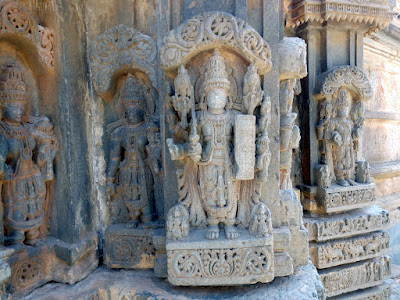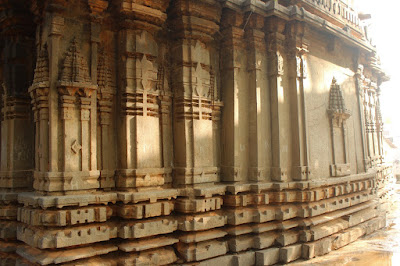...continued from Chennakeshava Devastana, Turuvekere.
Jan 27, 2023. After a good breakfast I left Turuvekere. On the way out I bought avarekayi since this is area is avarekayi belt. A similar looking avarekayi is grown around Dharwad but this variety lacks the aroma of southern Karnataka avarekayi. During the stop I inquired the route to Aralaguppe, two or three people I asked didn't know the exact route. And Google Maps may not be reliable in this part. Anyway, I followed the road in the general direction of Araluguppe. After 12.5 km at Banasandra I turned left. The road was condition was good, almost zero traffic, it was kind of desolate, lot of forks and side roads, it was a little confusing at forks... what side to go and no one in sight. I followed my intuition and the moment anyone came into sight, I stopped and confirmed if that was the right way. I reached Aralaguppe without getting lost and then I saw a board stating "Chennakesava Temple" less than 100 meters from it. This was the situation with Nagalpura as well. I wish government departments or local youth groups plant boards at junctions showing directions.
Aralaguppe seemed like a clean and peaceful little village. I parked my car close to the temple and as I entered the caretaker appeared. Like other ASI protected monuments, this caretaker told me not to shoot with DSLR but mobile was okay. To hear this verbal rule is always irritating. Why can't ASI put it in writing? I told the caretaker to convey my displeasure especially after having struggled to reach the place. I don't think he would convey my message to his boss at ASI. Anyway, let me start the tour of this magnificent temple built around 1250 CE during the rule of the Hoysala king Vira Someshwara.
A board planted in front at the entrance describes the temple as follows:
This Ekakuta temple was constructed in 13th century ad during the Hoysala period. It is built on a 4 feet high Jagati. The temple has a Garbhagriha, Sukanasi and Navaranga with an entrance porch at east. A separate shrine is built for Narasimha at south. The basement of the temple consists of fine friezes of rows of elephants, horses, scrolls and depiction of Puranic scenes. The walls are embellished with sculptures of Vishnu in his twenty-four forms flanked by Sridevi and Bhudevi, sculptures of Yaksha and Yakshi, Latangis and other secular themes all under Patralata-Torana. The noteworthy sculptures are Narayana, Lakshmi, dancing Ganesha, Mohini, Shadbhuja-Saraswati, Venugopala, Krishna, Lakshmi-Narasimha and Ugra-Narasimha etc. Many of these sculptures have the name of the sculptor as Honnoja inscribed below them. The Garbhagriha has a beautiful Shikara in four tiers of Vesara type. It is decorated with miniature turrets.
At the interior the Navaranga has beautiful pillars of Hoysala architectural features. The niches on the walls have sculptures of Ganesha and Mahishamardini. There is also a sculpture of Keshava about 6 feet high. The central ceiling (Bhuvaneshvari) has a row of Yakshas and a hanging flower bud. The Sukanasi doorway has Jalandras, Dwarapala and sculpture of Narayana flanked by miniature turrets. The Garbhagriha houses sculpture of Keshava of Hoysala period. The Prabhavali has miniature sculptures of Dasavataras of Vishnu.
This substructure is actually the Mukhamantapa. Normally Mukhamantapa are open, like a porch, but here the Mantapa has perforated slabs around it. The doorframe is relatively simple since it has a pair of undecorated slabs.
The architecture is standard Hoysala type with the temple sitting on a platform, the rear part of the platform is start-shaped in plan. The exterior walls have 3 main sections above which is the canopy. Every section has a theme of sculptures. The upper one has scale model temples, the mid section consists of idols of Vishnu and other characters, and the lower section is further divided into six tiers with specific theme. Starting with the lowest tier... elephants, horses, creepers, panels of legendary tales, Yalis and the topmost tier has swans.
Let's go around the temple in clockwise direction. The first idol is Vishnu seated on a coiled serpent Adishesha, the serpent's seven headed hood is sheltering Vishnu. Next, facing south is a four-armed Ganapati.
The following idols are mostly Vishnu & Lakshmi in different forms & postures. One of the idols here is Lakshmi-Narasimha, Lakshmi seated on Narasimha's lap.
I guess the idol on the left is Lakshmi-Narayana and on the right is four-armed Vishnu with Varada-Hasta the hand that grants boons.
Here are idols of standing Vishnu with Abhaya-Hasta the hand that assures protection & safety.
A glance at the upper section of the wall and the canopy. The star-shaped plan is consistent from the temple platform to the walls, the canopy and the Shikhara. The canopy's inner side too has details as seen in wood work. The canopy designs of Chalukyan temples and Hoysala temples are different.
Then here's a four-armed Vishnu with Shankha, Chakra, sword and shield. He looks he's ready for a small confrontation.
Vishnu on the right has both Varada-Hasta and Abhaya-Hasta.... take a boon and be protected. Vishnu on the left is holding a plant like object with his rear-right hand. No idea what it signifies.
Moving on, there's a Vishnu's Avatar Krishna. Krishna is subduing Kaliya the evil serpent by stepping on its head. Part of the serpent is missing, broken by the same vandals who have defaced many of the idols here.
On the south-western side of Chennakesava temple is another structure which is fully enclosed. This second temple, a south-facing one, is dedicated to Ugra Narasimha sits on a rectangular platform. This temple has no Shikhara but an ornate stucco crown. Going by the architecture this seems like a Vijayanagara time addition.
There was news about plans for relocating this temple however the plan was shelved due to objections from village folks. If not for this temple, we would've had a clear view of Chennakesava temple.
A glance at the highly complicated Shikhara also called Vimana. This is a three tiered Shikhara.
One of the corners of the star-shaped platform. This particular corner is aligned to the Garbhagudi Theerta. The other interesting thing here are the stone elephants placed at few of the corners. Going by the looks of the stone work of the platform, it seems like original condition. Even if it were redone, it was not later than Vijayanagara times, I feel.
A closer look at one of the elephants.
Coming to the northern side. Most of the idols of Vishnu were more or less the same unless I missed something. I wonder why other Avatars of Vishnu haven't been represented, for example Matsya, Kurma, Varaha or Vamana. Anyway, on this side I found some interesting sculptures of bullock carts and wagons. See the tandem carts and three pairs of oxen hitched on to them.
Here we have one cart and two wagons. On the cart are two people and a piece of furniture. Behind the cart are stacks of pots, probably waiting to be loaded and transported. In those times for wagons to be used roads must've been pretty good. It would be interesting to delve into the traffic rules of those times ...wondering if there are any records.
The northern wall of the Sabhamanatapa, idols of Vishnu in his usual form.
Back to the front, the other side of Mukhamantapa. Perforated stone slabs between the pillars blocks direct view of the interior.
A pair of Mantapa flanks the platform steps. None of the Hoysala temples seen in Tumkur district have had balustraded steps which is a common feature in Chalukyan temples.
I thanked the caretaker and prepare to leave. One other spot to see at Aralaguppe is Kalleshwara group of temples situated on the lake bank. A few yards from the temple gate are a pair of standing stone slabs. Lets take a look at them in the next post.



















































